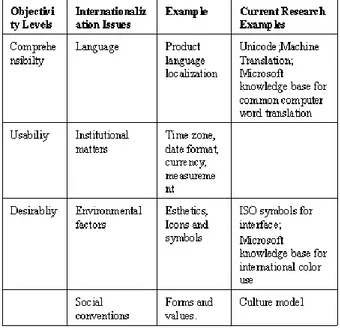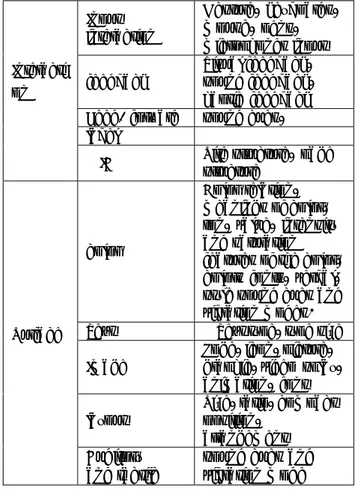A cross-cultural frame on user interface website
료핑*, 반영환 Liu ping, Youngwan Pan
국민대학교 테크노디자인전문대학원 인터랙션다자인 전공Key words: cultural factor, globalization and Localization,website frame
1. Introduction
In an increasingly global marketplace UI designer are faced with the challenge of offering usable products and services to an enormous variety of users. So far, the researchers involved are try to develop or evaluate the usability of website and machine in different cultural contexts. However, their research concentrates on the technical level. The field lacks a systematic theory and the development in principle, how to convert the result directly to the steps for designers, its challenges and the difficulties of development. In addition,cross cultural analysis and design issues will need to be considered more integrally in planning stages, and developers will need check lists and guidelines to assist them in their design phases. We propose a design element for cross-cultural user interface based on the summary of the past research findings about user interface website cross-cultural differences.
2. Cross-Cultural and UI design
2.1
Localization and GlobalizationFrom a cross-cultural usability perspective, localiz- ation refers to the adaptation of a product, applica-tion or document content to meet the language, cultural and other requirements of a specific target market (a locale) [1]. Localization is the process of adapting a product or service to a particular language, culture, and desired local "look-and-feel." In localizing a product, in addition to idiomatic language translation, such details as time zones, currency, local color sensitivities, product or service names, gender roles, and geographic examples must all be considered. A successfully localized service or product is one that
appears to have been developed within the local culture. I am categorizing these issues into four categories with three levels of objective. The following table1. lists them form surface to bottom level.
Table 1.Internationalization Issues and levels
2.2. Cultural markers and UI design
The term‘Cultural markers’was grist coined by We-ndy Barber and Albert Badre to refer to ‘Cultural markers are interface design elements and features that are prevalent, and possibly preferred, within a particular cultural group.’it is used to define “the interface design elements of the website that reflect the signs and the meanings to match the expecta-tions of the local culture .the culture attractors typ-ically comprise of colors ,color combinations, ban-ners, the use of metaphor ,language clues, naviga-tion controls and similar visual elements that toget-2012년 한국감성과학회 춘계학술대회
her create a ‘look and feel’to match the cultural expectations of the users for a particular domain ” (Barber and Badre,1998).
3. Cross-Cultural and UI design frame
3.1 Cross-Cultural UI design frameAs a result of this conclusion, the elements that can be formed by cultural characteristics in a webpage design have been determined in terms of user features and user expectations as the content and Hoft,N(1996). So, In the entire UI design Culture related factors, including: functional, interaction and surface (Table 2)
Function is about Individual level , include persona-lization information, information content, informati-on sequence, informatiinformati-on scope. Examples include Main content, secondary content , documents, bo-okmark, help, ect. The regarding the functional sp-ecification and content description in the web page. Interaction is about input/output techniques, in-cluding feedback example include the choices of keyboard,mouse, pens, or microphones for in-put; the choices of visual display screens, loud-speakers, or headsets for output ; and the use of drag-and-drop selection /action sequences. Surface is about visual(text, color properties, ima ge),auditory, and tactile characteristics, i.e., per-ceptual attributes. examples include choices of colors, fonts, verbal style (verbose/terse or informal /for-mal),sound cues and vibration modes.
Table 2. A cross-cultural frame on user interface website Item element s Segments elements example Function personalization Optional, configurable, created Information content Main content, secondary content ,documents, bookmark, help Information sequence Scope Functional specificati ons and content des cription Interacti on Input interaction Gesture, keyboards, mouse, pens, microphones input feedback Visual feedback, sound feedback, haptic feedback Feed-forward sound cues, label
IA Site structure, page structure
Surface
color
Color relation, meanings of color, ton, value, intensity and saturation features of the color, colors fonts, verbal, style sound cues and vibration modes. Text Text type, type size
Image
Loge, icon, picture, graphic, video splay, animation, font
layout
Size, ratio, compact position,
arrangement Auditory
and tactile
sound cues and vibration mode
5. conclusion
Essentially, this Cross-Cultural UI design is based on the theoretical study, therefore the case study is necessary to reflect subjective culture in the design of interface. Future research will include alternate data collection modes such as interviews, direct observation of user behaviour, and focus groups. Also, questionnaires will be administered to overseas subjects in their Local cultures, to minimise potential cultural problems of the current study.
References
Hoft, N.: Developing a Cultural Model. In: Del Galdo, E., Nielson, J. (eds.): International User Interfaces. John Wiley and Sons, New York (1996).
Marcus, A. (2002). Global and intercultural user-interface design. In J. A. Jacko & A. Sears (Eds.), The humancomputer interaction handbook: Fundamentals, evolving Technologies and emerging applications (pp. 441-462). Mahwah, NJ: Lawrence Erlbaum.
2012년 한국감성과학회 춘계학술대회

